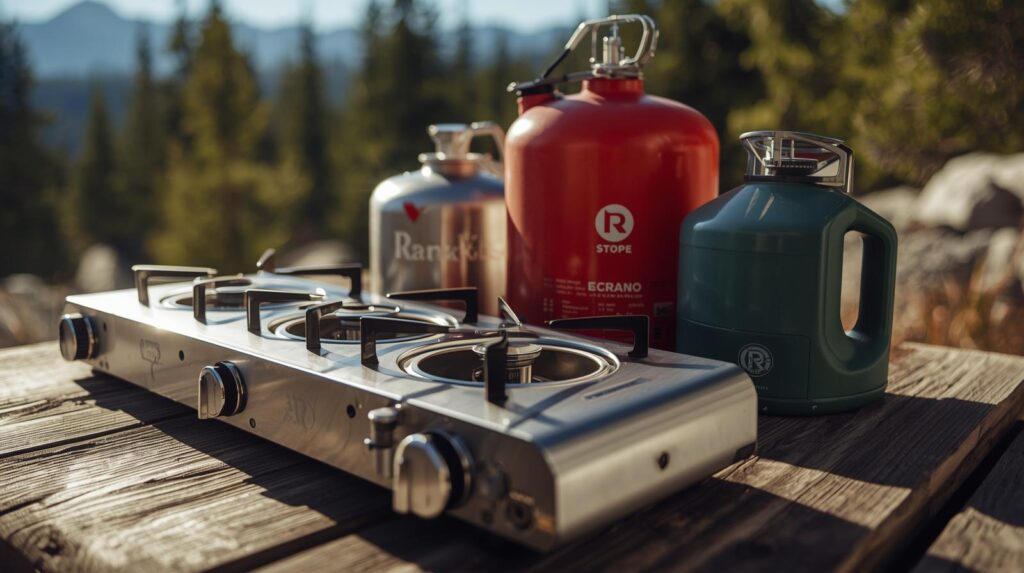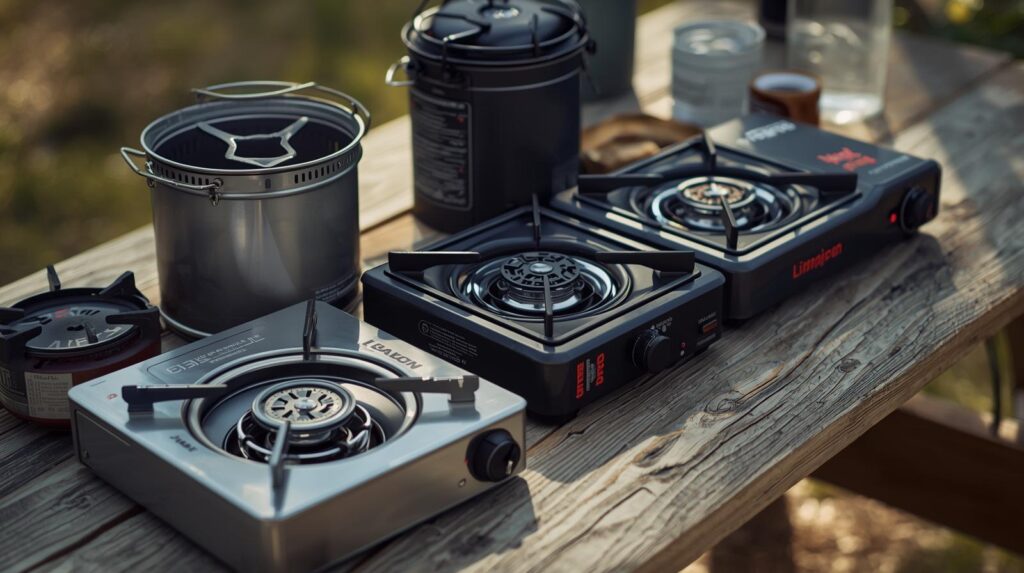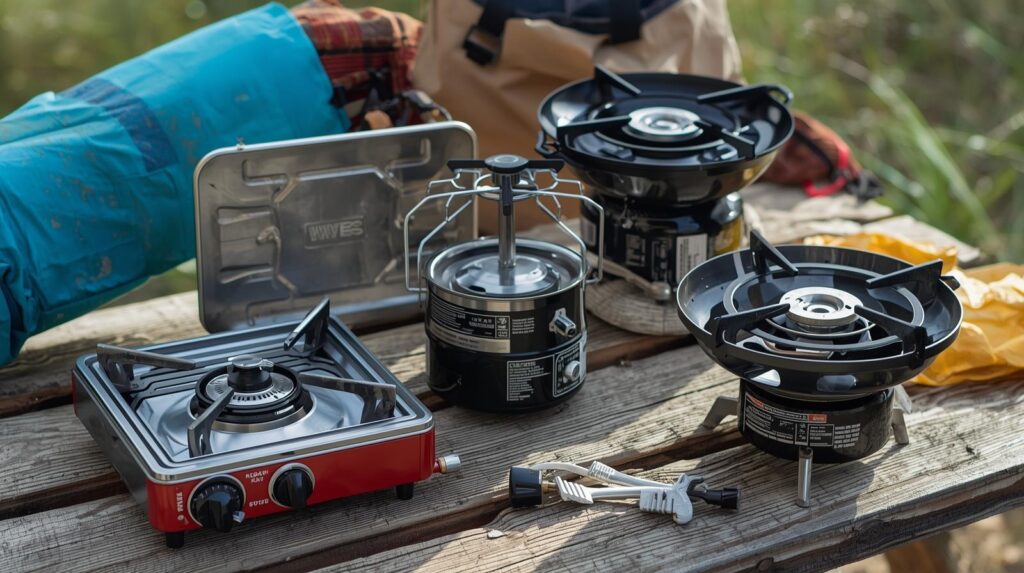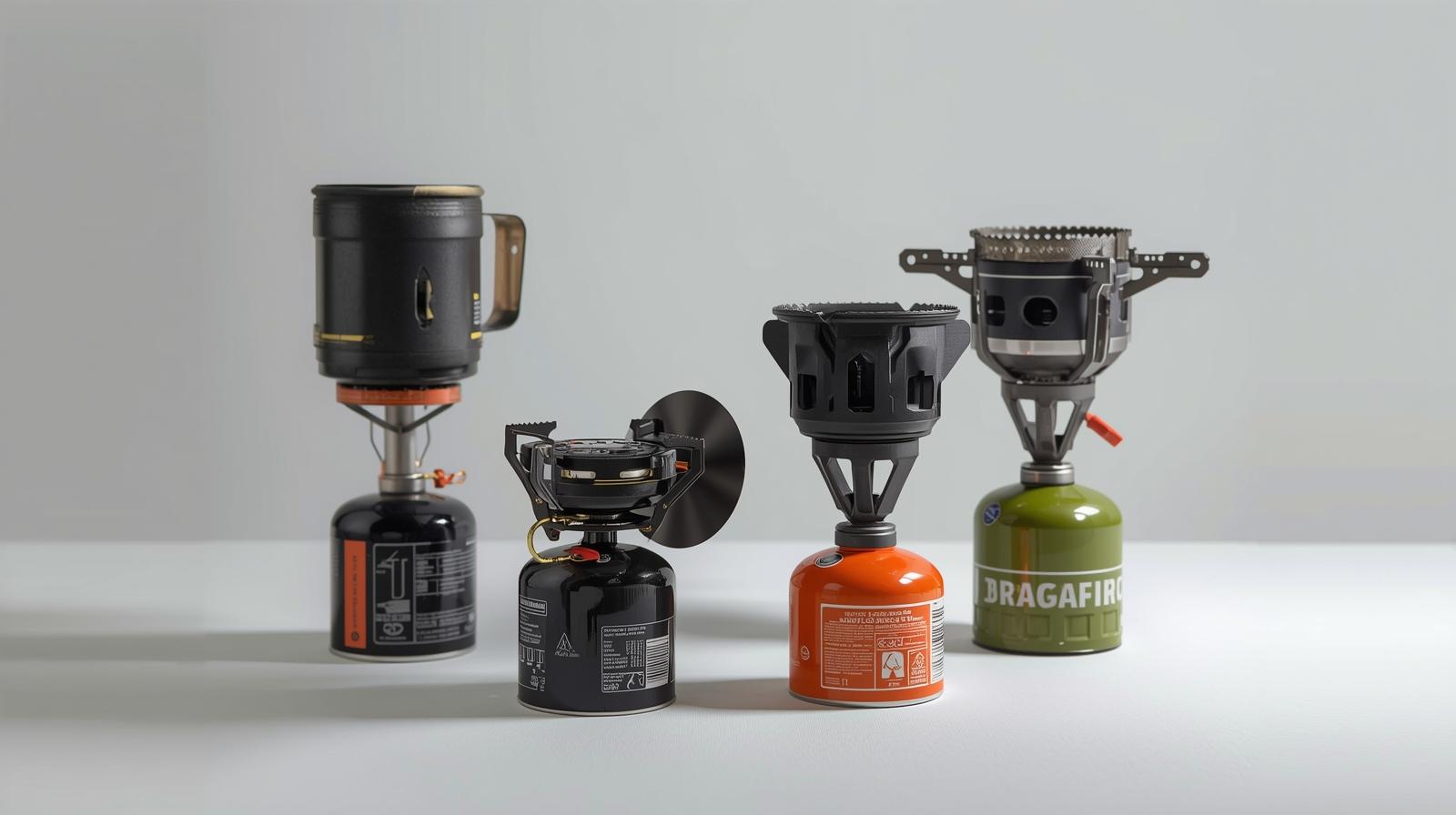A portable outdoor stove is the undisputed centerpiece of any camp kitchen. It provides the freedom to cook anywhere, turning basic ingredients into satisfying meals whether you’re miles into the backcountry or set up beside your vehicle.
However, the term “best portable outdoor stove“ means something different to a backpacker watching every ounce than it does to a car camper feeding a family. To help you choose the perfect model for your needs, we have categorized the six top-performing and most popular stoves available on Amazon, analyzing the distinct features, pros, and cons of each type.
Choose the Best Portable Outdoor Stove Today for Camping!

Category 1: The Car Camping Powerhouse (Dual-Burner Propane)
These stoves are built for convenience, high-heat output, and feeding multiple people. They are the ideal choice for family camping, tailgating, or basecamp cooking where weight and space are less of a concern. They primarily use liquefied petroleum gas (LPG), typically from 1lb propane canisters.
Stove 1: The High-Output Dual-Burner Tabletop Stove
This classic foldable design offers the most versatility for group cooking. They typically feature two large, powerful burners with integrated windscreens, making them a reliable workhorse for full-scale meal preparation.
| Feature Breakdown | Details |
| Heat Output | High (Often $20,000$ BTU or more per burner). Excellent for fast boiling and searing. |
| Simmer Control | Good-to-Excellent on premium models, allowing for precise heat regulation. |
| Portability | Folds into a briefcase-style box (medium bulk, medium weight – $10-17$ lbs). |
| Wind Protection | Integrated side and rear windscreens are standard and highly effective. |
| Fuel Source | 1 lb Propane Canisters (easy to find), or connected to a bulk $20$ lb tank with an adapter. |
Pros:
- Group Cooking: The ability to run two large pots/pans simultaneously is essential for families and groups.
- Fuel Reliability: Propane works well in a wide range of temperatures and at moderate altitudes.
- Durability: Built from durable steel with a simple, rugged mechanism that handles frequent use.
- Ignition: Most models feature a reliable piezo (push-button) igniter, eliminating the need for matches.
Cons:
- Weight & Bulk: Too heavy and large for hiking or backpacking; strictly for car-dependent trips.
- Cleanup: Spills and grease can be challenging to clean from the burner area and folding seams.
- Environmental Waste: Requires managing disposal or recycling of the $1$ lb disposable propane canisters.
Stove 2: The Multi-Purpose Stove and Grill Hybrid
This is the ultimate convenience model, combining a traditional high-output burner with an interchangeable grill or griddle surface. It’s perfect for the camper who wants to cook a breakfast of pancakes and eggs, followed by grilled burgers, all on one portable unit.
| Feature Breakdown | Details |
| Heat Output | Moderate to High, with specific zones optimized for direct grilling. |
| Versatility | Includes removable cast iron or non-stick surfaces (grill grate, griddle plate, burner grate). |
| Portability | Similar to the dual-burner, but often slightly heavier due to integrated cast-iron cooking surfaces. |
| Fuel Source | 1 lb Propane Canisters. |
Pros:
- Maximized Menu: Allows for full grilling, griddling, and standard pot/pan cooking.
- Cast Iron Flavor: The grill/griddle plates often deliver superior heat retention and classic outdoor flavor.
- Easy Cleaning: Removable, sometimes non-stick surfaces simplify post-meal cleaning.
- All-in-One: Replaces the need to pack a separate grill and a standard camp stove.
Cons:
- Lower BTU on Grill: The grilling side might not reach the searing temperature of a dedicated gas grill.
- Small Wind Screens: The hybrid design often means less robust wind protection for the burners than traditional dual-burner stoves.
- Expensive: This multi-functional design comes with a higher initial price tag.
Category 2: The Backpacking Specialist (Ultralight Canister Stoves)

When every ounce counts, the canister stove is king. These stoves are small enough to fit inside a cooking pot, utilize high-efficiency fuel (isobutane/propane mix), and are engineered for quick water boiling.
Stove 3: The Ultralight Screw-on Canister Stove
This is the quintessential minimalist best portable outdoor stove. It consists of a tiny burner head and folding pot supports that screw directly onto the top of a threaded fuel canister.
| Feature Breakdown | Details |
| Heat Output | High. Excellent for rapid boiling (often under $3$ minutes for 1L of water). |
| Simmer Control | Variable. Budget models offer poor control; premium models are surprisingly capable. |
| Portability | Extremely light ($2-4$ oz) and compact (fits in a coffee mug or small pot). |
| Wind Protection | Poor. Highly vulnerable to wind, requiring an external windscreen (use only below the burner). |
| Fuel Source | Isobutane/Propane Canisters (threaded connection). |
Pros:
- Ultralight: The lightest stove option, making it essential for thru-hiking and minimalist backpacking.
- Instant Ignition: Many come with a built-in piezo igniter.
- Simple Setup: Ready to use in seconds—just screw it onto the canister.
- Affordability: Budget models are extremely inexpensive and widely available.
Cons:
- Cold Weather Performance: Isobutane fuel suffers greatly in cold temperatures and at high altitudes (above $8,000$ ft).
- Stability: The high center of gravity (the stove sits on top of the fuel canister) is unstable, especially with large pots.
- Fuel Canister Waste: Creates a disposable waste product (empty fuel canisters).
Stove 4: The Integrated All-in-One Stove System
Designed purely for efficiency and speed, this system combines the burner, heat exchanger, and cooking pot into a single unit. It is engineered to deliver the fastest boil times possible, making it perfect for rehydrating freeze-dried meals and boiling water for drinks.
| Feature Breakdown | Details |
| Heat Output | Hyper-efficient heat transfer, not raw BTU. Focuses energy directly into the pot. |
| Simmer Control | Generally poor on “Flash” models; better on “Regulated” models. |
| Portability | Light-to-medium weight ($10-16$ oz) and all components nest perfectly inside the cooking cup. |
| Wind Protection | Excellent. The burner is often recessed or shielded, making it highly wind-resistant. |
| Fuel Source | Isobutane/Propane Canisters. |
Pros:
- Blazing Fast: Unmatched boil times (often less than $2.5$ minutes per liter).
- Exceptional Efficiency: Uses less fuel than traditional canister stoves per boil.
- Self-Contained: Everything, including the fuel canister base and stabilizer, packs away neatly.
- Easy Meal Prep: Ideal for quick-and-easy water boiling for coffee, tea, or dehydrated meals.
Cons:
- Limited Cooking: Best for boiling water. It struggles with or cannot accommodate standard frying pans or skillets.
- Proprietary Design: You are generally limited to using the included cup/pot designed for the system.
- High Cost: Integrated systems are one of the priciest ultralight options.

Category 3: The Self-Sufficient & Survivalist Choice (Alternative Fuel)
These stoves appeal to those seeking fuel independence (reducing reliance on gas canisters) and those prioritizing sustainability, fire ambiance, or extreme cold-weather performance.
Stove 5: The Wood-Burning Gasifier Stove
This unique stove generates intense heat using small twigs, leaves, pinecones, and other biomass found locally. It works by burning the wood in a double-walled chamber, heating the air, and injecting hot air back into the fire to create a clean-burning secondary combustion (gasification), resulting in minimal smoke.
| Feature Breakdown | Details |
| Heat Output | High. Produces an intense, sustained flame once fully burning. |
| Fuel Source | Free, renewable biomass (wood, twigs, leaves). Some models have a backup alcohol burner option. |
| Portability | Collapsible, medium weight ($12-18$ oz). Requires no fuel canister carriage. |
| Key Advantage | Eliminates the need to carry fuel, offering true independence. |
Pros:
- Fuel Independence: Never run out of fuel as long as dry biomass is available.
- Eco-Friendly: Uses renewable, carbon-neutral fuel and leaves no canister waste.
- Ambiance: Provides the visual and heating element of a small, contained fire.
- Cold Weather: Performs reliably in cold temperatures and high altitudes where gas canisters fail.
Cons:
- Constant Feeding: Requires near-constant attention and feeding of small wood scraps to maintain the fire.
- Smoke & Soot: While minimized by gasification, it still produces some smoke and leaves heavy soot/black residue on cookware.
- Fire Bans: Cannot be used during official burn bans or in areas with very high fire danger.
Stove 6: The Multi-Fuel (White Gas/Liquid Fuel) Stove
The professional choice for expeditions and extreme cold. These stoves use pressurized liquid fuels (like white gas, kerosene, or even unleaded gasoline in emergencies) and are known for their reliable performance in the harshest environments.
| Feature Breakdown | Details |
| Heat Output | Extremely High and regulated. Excellent for fast boiling in extreme conditions. |
| Fuel Source | Pressurized liquid fuel (White Gas/Naptha is recommended). |
| Portability | Stove head is light, but the required separate fuel pump and fuel bottle add weight and bulk. |
| Cold Performance | Best in class. Pressure regulation ensures consistent power regardless of air temperature or altitude. |
Pros:
- Extreme Cold/Altitude: The only reliable choice for mountaineering and polar expeditions where other fuels fail.
- Fuel Availability: Liquid fuel is easier to find globally than isobutane canisters.
- Refillable: Fuel bottles are refillable, significantly reducing waste over canisters.
- High BTU: Delivers consistent, powerful heat output for large pots.
Cons:
- Learning Curve: Requires manual pressurization (pumping) and a pre-heating/priming process to operate safely.
- Messy: Refueling and priming can be messy, leading to spilled fuel and a strong chemical odor.
- Noise: Older models are famously loud (“jet-engine sound”) during operation.
Best Portable Outdoor Stove Buyer’s FAQ
Q1: What is the biggest downside to using an Isobutane/Canister stove?
A: The biggest downside is inconsistent performance in cold weather or at high altitude. As the fuel canister cools, the pressure drops, and the stove’s flame becomes weak and ineffective. If your trip involves temperatures near freezing or elevations over $8,000$ feet, you should choose a Liquid Fuel (White Gas) or Wood Gasifier stove instead.
Q2: What is “BTU” and why does it matter for a car camping stove?
A: BTU (British Thermal Unit) is a measure of the heat output of a burner. For a car camping stove:
- High BTU ($\ge 10,000$ per burner): Means faster boiling times and the ability to cook at higher temperatures (good for searing/wok cooking).
- Low BTU ($< 10,000$ per burner): Will be slower, but often offers better simmer control for delicate cooking tasks.
Q3: Are wood-burning stoves allowed during a fire ban?
A: Generally, no. Most official fire bans include all wood and charcoal burning, regardless of whether it is contained in a specialized stove. This is because the stove produces sparks and embers that can escape. Always check the local regulations (State Park, National Forest, BLM office) before using any wood-burning device.
Q4: How do I make my small canister stove more stable?
A: You can significantly improve stability by using a remote canister stove (where the fuel canister sits off to the side, connected by a fuel line) instead of a top-mounted one. For top-mounted stoves, always purchase a separate, folding canister stabilizer base that clips onto the bottom of the fuel can to widen its footprint.
Q5: Is it safe to use White Gas or Liquid Fuel stoves inside a tent or vehicle?
A: Absolutely not. Portable stoves must only be used outside and away from flammable materials. All portable fuels, especially liquid fuels, produce carbon monoxide (CO)—an odorless, invisible, and lethal gas. Using any stove indoors, even with ventilation, carries a serious risk of carbon monoxide poisoning.
Q6: How can I tell how much fuel is left in my isobutane canister?
A: Since you cannot see the fuel level, the best way to check is to weigh the canister.
- Check the “empty” or “tare” weight (usually stamped on the bottom of the canister in grams).
- Weigh the current canister on a digital scale.
- Subtract the tare weight from the current weight to find the amount of fuel remaining.
Final Recommendation
When choosing the best portable outdoor stove, your choice boils down to your trip type:
- For Car Campers & Families: Opt for a high-output, Dual-Burner Propane Stove for cooking versatility and reliable heat.
- For Backpackers & Hikers: Choose the ultralight efficiency of an Integrated All-in-One Canister System for fast, simple meals.
- For Extreme Conditions & Self-Reliance: Invest in the reliable power of a Liquid Fuel (White Gas) Stove for year-round, global performance.
